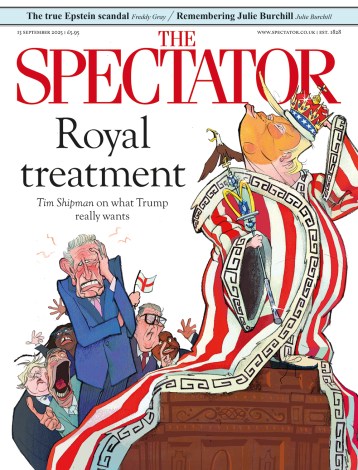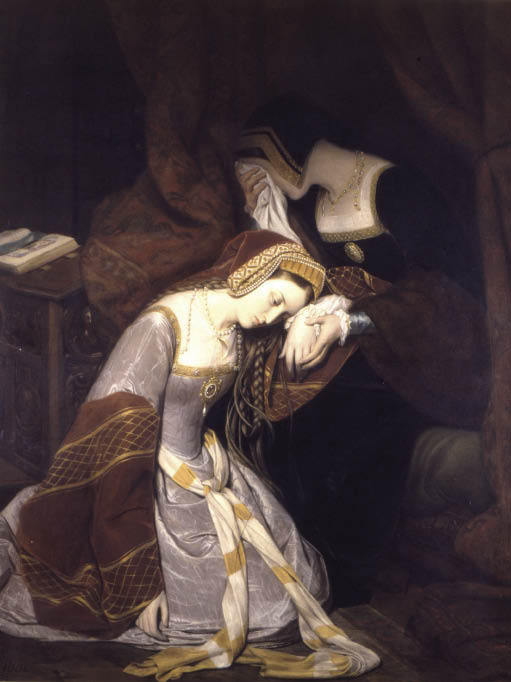Painting History: Delaroche and Lady Jane Grey
National Gallery, until 23 May
Just up the road from where I write is the dramatic ruin of Framlingham Castle, the historical seat of the Howard family and the Dukes of Norfolk. The castle was granted to Princess Mary by her half-brother King Edward VI, and she took refuge there when on Edward’s death his second cousin Lady Jane Grey was named as his successor, rather than she herself. The country was in the grip of its worst period of internal religious strife, which Protestant Edward had tried to avoid by commending devoutly Protestant Jane to the crown. But the Catholics would have none of it, and Mary’s star was very soon in the ascendant. She rode from Framlingham to London to lead the counter-coup which would unseat Lady Jane Grey, and which would result in her own coronation as Mary I, soon to earn the nickname of Bloody Mary.
I mention this here because the centrepiece of this new exhibition is one of the most popular paintings in the National Gallery, ‘The Execution of Lady Jane Grey’, by Paul Delaroche (1797–1856). For the duration of this show, the public will have to pay to see it, in company with other paintings by Delaroche and some by his contemporaries. The first question to be addressed is whether the display mounted around it is worth the hefty admission charge (£8 or concessions). At once the chief problem with exhibitions using the Sainsbury Wing emerges — its inflexibility. There are a certain number of rooms there, and exhibitions are deemed to have to fill them. Why? Value for money, I suspect. Perhaps if half the rooms were shut off the public would baulk at the admission charge. But if the show is plumped out with minor work (engravings, for example), then surely visitors will feel cheated? It’s a delicate balance.
Who, you may ask, was Paul Delaroche? An Anglophile Frenchman, he was an academic painter who managed to be the most successful artist in Europe at the time when our National Gallery was first established. His popularity rested upon the ability to mingle the Romantic with well-researched and eye-catching realism. Undoubtedly sentimental and addicted to narrative suspense, Delaroche nevertheless gave the public what it wanted. The irony remains that it took a foreigner to interpret our history for us.
The first room of the exhibition shows how artists were drawn to the depiction of the past, mostly in a pious or poetic way. In this collection of lacklustre pictures (especially dreary is the dim church interior by Granet, better remembered today for the museum which bears his name in Aix-en-Provence), the painting by Richard Parkes Bonington based on Walter Scott’s ‘Quentin Durward’ stands out for its lively and vigorous brushwork. The second room focuses on the impact of England as subject matter for the susceptible French and shows us two large canvases by Delaroche: ‘The Princes in the Tower’ and ‘Cromwell and Charles I’. I wish I could find these pictures more interesting. The walls between them are filled with engravings and a sheet of rather stiff drawings of armour by Delacroix. The third room concentrates on the influence of the theatre on art, and includes drawings by Delaroche. Much more beguiling is another little picture by Bonington; his paint-handling far superior to anything Delaroche could manage.
Cut to the chase: Room 4 contains the Lady Jane Grey painting we’ve all been waiting for, hung in front of dark purple drapes. The most striking thing about this large canvas is the uncertain awkward gesture of Lady J feeling her way to the block, amid wailing and fainting ladies-in-waiting. Of course the drama and pathos are mostly invented. She is depicted in virginal white, yet by all accounts was dressed in plain black, and she’s shown here helplessly blindfold, yet eyewitnesses make no mention of this. Lady J is comforted and guided by Sir John Brydges, Lieutenant of the Tower, whose rich robes are a brilliant foil to her pallor. To the right stands the axeman, quiet and compassionate. Another conspicuous element is the artful scatter of straw beneath the block, a beautifully decorative symbol of the transitoriness of life.
Among the other paintings in this central gallery are ‘Young Christian Martyr’, with a halo horribly reminiscent of the ‘ring of confidence’ a certain toothpaste confers, the high-toned kitsch of ‘Saint Cecilia and the Angels’, and ‘Strafford on his Way to Execution’, which has a distinct theatrical presence, though rather overdone. Room 5 has more of Delaroche’s drawings (better ones) and a rather lovely portrait of his mistress, Mademoiselle Anaïs, sensitively drawn in coloured chalks. The last room traces Delaroche’s influence among such artists as his pupil Gérôme.
It is, I suppose, appropriate that Lady Jane Grey should be confined to the dungeons of the National Gallery’s Sainsbury Wing. Her reign was a mere Nine Days’ Wonder, after which she was arrested and executed for treason, though Mary would have liked to spare her. In fact, Mary was probably a lot less bloodthirsty than her nickname leads us to believe, but was betrayed by her advisers and her own growing panic into a series of acts which have understandably blackened her memory. Compare the reputation of Charles I, another stubborn monarch, but one with the cultivated interest to be a considerable art collector. He has the character of being a saintly man, who suffered unjustly for what he believed. Another oversimplification. However, Delaroche’s painting ‘Charles I Insulted by Cromwell’s Soldiers’ (1837) supports this reading of the King’s personality, depicting him as almost Christ-like, just moments before his execution.
This painting is not part of the Sainsbury Wing exhibition, but forms a separate display in Room 1 (admission free). It has only recently been rediscovered after being severely damaged by bombs in the second world war and put away for safe-keeping. It will be fully restored but currently is still attractively battle-scarred. It is much more dramatic and worth seeing than most of the exhibits in the paying exhibition, and I have no hesitation in recommending this picture for further perusal. If you’re uncertain as to whether you will appreciate the full Delaroche experience, and hesitate over buying a ticket for the exhibition, why not consult the luxurious hardback catalogue (priced at £19.99) first. Browse it in the shop: that should give you the flavour of the show and help you make up your mind.






Comments